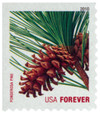
2010 First-Class Forever Stamp, Holiday Evergreens: Ponderosa
# 4482 - 2010 First-Class Forever Stamp - Holiday Evergreens: Ponderosa
$0.50 - $3.75
U.S. #4482
2010 44¢ Ponderosa Pine
Holiday Evergreens
Issue Date: October 21, 2010
City: New York, NY
Printed By: Ashton Potter
Printing Method: Offset
Color: Multicolored
Evergreens like Ponderosa pine are used to decorate homes during the Christmas season. Named for its ponderous size, the Ponderosa pine has stout, open branches and excellent needle retention. It has been harvested for railroad ties, telegraph poles, and furniture veneer, and is the official tree of Montana.
Centuries ago, pagans carried evergreens into their homes during Winter festivals to represent their idols. Apples and other fruit were placed on branches as offerings to the tree. Some historians believe the modern custom of placing gifts beneath the Christmas tree began with this practice.
Homesick Hessian soldiers are credited with introducing Christmas trees to the American Colonies during the Revolutionary War. The practice spread quickly as German immigrants settled across the United States during the 1800s, and has become a holiday tradition.
In 1931, workers constructing New York City’s Rockefeller Center decorated a small tree with “strings of cranberries, garlands of paper, and even a few tin cans” on Christmas Eve. A tree has been erected in Rockefeller Center every year since, and has become the city’s unofficial signal that the holiday season has begun.
U.S. #4482
2010 44¢ Ponderosa Pine
Holiday Evergreens
Issue Date: October 21, 2010
City: New York, NY
Printed By: Ashton Potter
Printing Method: Offset
Color: Multicolored
Evergreens like Ponderosa pine are used to decorate homes during the Christmas season. Named for its ponderous size, the Ponderosa pine has stout, open branches and excellent needle retention. It has been harvested for railroad ties, telegraph poles, and furniture veneer, and is the official tree of Montana.
Centuries ago, pagans carried evergreens into their homes during Winter festivals to represent their idols. Apples and other fruit were placed on branches as offerings to the tree. Some historians believe the modern custom of placing gifts beneath the Christmas tree began with this practice.
Homesick Hessian soldiers are credited with introducing Christmas trees to the American Colonies during the Revolutionary War. The practice spread quickly as German immigrants settled across the United States during the 1800s, and has become a holiday tradition.
In 1931, workers constructing New York City’s Rockefeller Center decorated a small tree with “strings of cranberries, garlands of paper, and even a few tin cans” on Christmas Eve. A tree has been erected in Rockefeller Center every year since, and has become the city’s unofficial signal that the holiday season has begun.









